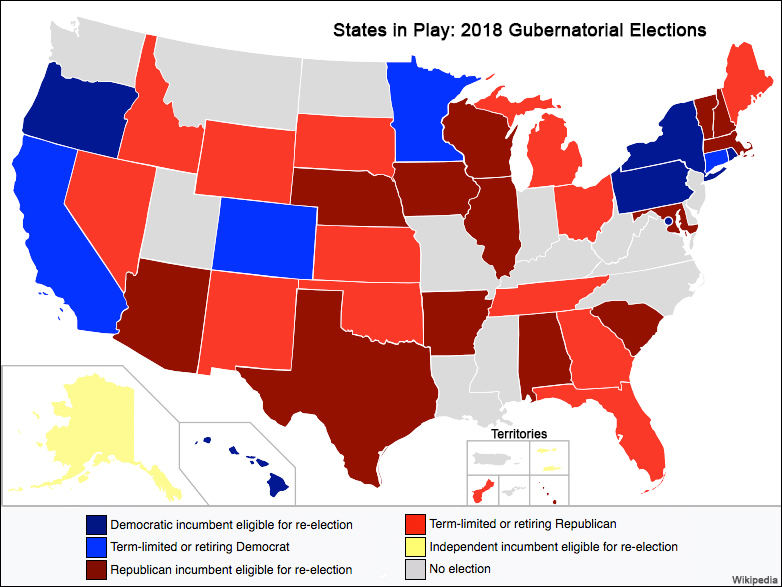By Jim Ellis
Jan. 25, 2018 — Earlier this month, we set the stage for the Senate and House campaigns. Today, we look at another important election platform, that of the nation’s governors. Though these races will elect people who will obviously determine future individual state policy, most of the 2018 gubernatorial winners will carry redistricting veto power in 2021. Therefore, these elections also carry national implications.
Of the 36 governors’ campaigns, 17 will be open races mostly due to state term limit laws. While the Democrats must protect the preponderance of US Senate seats this year, the opposite situation exists in the governors’ races. Here, Republicans must defend 26 state houses, 13 of which are open seats.
Of the 13 GOP incumbents seeking re-election, three are actually running for governor for the first time. Govs. Kay Ivey (R-Alabama), Kim Reynolds (R-Iowa), and Henry McMaster (R-South Carolina) were all lieutenant governors who ascended to their current position because the person elected in 2014 is no longer in office.
Alabama’s Gov. Robert Bentley (R) was forced to resign as part of a plea bargain arrangement over campaign finance violations. The other two state chief executives, Terry Branstad (IA) and Nikki Haley (SC), accepted positions in the Trump Administration. At this point in the election cycle, all three unelected governors are favored to win a full term.
Currently, it appears as though the Democrats are poised to make slight gains in the nation’s state houses. Illinois Gov. Bruce Rauner (R), who trails in early polling, must run in a state that is becoming a solid Democratic stronghold. Additionally, the open Republican seats in Maine (Gov. Paul LePage) and New Mexico (Gov. Susana Martinez) could be ripe for a Democratic conversion.
Two more Republican states are in toss-up mode, featuring hotly contested open races in Michigan (Gov. Rick Snyder) and Nevada (Gov. Brian Sandoval). Pennsylvania Democrat Gov. Tom Wolf also could be headed into a pick-‘em situation since his approval ratings have consistently lagged.
Republicans are in position to contest competitive open Democratic seats in Colorado (Gov. John Hickenlooper), Connecticut (Gov. Dan Malloy), and Minnesota (Gov. Mark Dayton). They also appear to be organizing for a strong challenge to Rhode Island Gov. Gina Raimondo (D) in a domain that heavily supports Democrats but has elected a Republican to the state house for 22 of the last 34 years.
The GOP must also protect vulnerable state houses in Florida and Ohio, where incumbents Rick Scott and John Kasich are ineligible to seek re-election. Govs. Scott Walker (Wisconsin) and Larry Hogan (Maryland) also face tough political battles later this year. Though Vermont Republican Gov. Phil Scott won two years ago in one of the nation’s most reliable Democratic states, his approval ratings are such that he becomes a clear favorite to win a second term. Vermont and neighboring New Hampshire are the only two states that give their chief executives two-year terms.
Wisconsin’s Gov. Walker, who briefly was a presidential candidate in 2015, is running for re-election to a third term. He also faced a re-call election back in 2012, a vote that actually increased his political strength. No less than 16 Democrats have announced their candidacies, but the party won’t have a nominee until the Aug. 14 primary, which will likely put the eventual winner in a difficult position against the aggressive and well-funded Gov. Walker.
Maryland is another strongly liberal state that elected a Republican in 2014. Therefore, Gov. Hogan, though consistently receiving some of the strongest job approval ratings in the country, can be projected as no more than a slight favorite in a state with such a predominant Democratic voting history.
Most of the 36 gubernatorial elections will be among the most important of this election cycle and promise to absorb prolific political attention.

